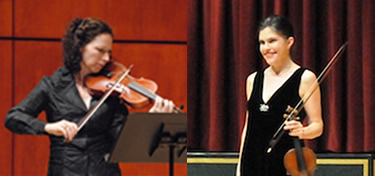Meymandi Concert Hall resonated with Moorish modes and Spanish rhythms as the North Carolina Symphony honored the magnificent exhibit at the Nasher Museum in Durham entitled “From El Greco to Velasquez: Art During the Reign of Philip III.” Before the concert, Flamenco dancers punctuated the atmosphere with heel-clicks and had-claps and shrill R-r-r-r-r-rrrrrrrrrrrrrr-s from the lower lobby while, in the opposite corner of the building, composer Stephen Jaffe explained all the external elements which had influenced him while composing the opening work of the concert, “Cithera Mea.”
Jointly commissioned by the Nasher Museum and the North Carolina Symphony to celebrate the El Greco-Velasquez exhibit, “Cithera Mea” (“My Harp”), draws its musical inspiration from 16th-century secular songs and dances as well as from sacred music of the period. The title is derived from the Book of Job, whose text figured in motets sung at both the funerals of Philip II, in 1598, and his sister ,Empress Maria, in 1603.
The composer, in his writings and discussions of the piece, would have us also draw in other influences such as the actual ambient acoustics and local sounds of the cathedral of Toledo today and a journal of museum-goers photographed while looking at significant works of art. This reviewer found all the added elements distracting, making the music less important than the slide shows, taped comments, laughter, and loud footsteps. However, Professor Jaffe also invites us to enjoy the work “as a piece of music, plain and simple,” which invitation I accepted, having found the gem more interesting than the setting.
Imagine the modal dances of centuries long past, played with modern instruments, enhanced by the current thinking about contrast, fit, and juxtaposition, and using musical devices originating in the 1960s – clusters (handfuls of non-consonant notes, played like chords) and colorful percussion. Jaffe is a master of orchestration and uses all these elements with a great sense of purpose – in other words, the piece works. And it works well – it has an interesting shape, is tonal, and yet it is spiked with interesting and unexpected flavors. I would love to hear a sound recording of the work. I honestly think this music has a future on its own, relieved of a screen filled with words and slides and voice-overs.
Joaquin Rodrigo is best known for three concertos for guitar, the popular Concierto de Aranjuez, the lesser-known Fantasía para un gentilhombre and the work of this evening, a concerto for four guitarists, the Concierto Andaluz, commissioned and first performed by the celebrated Romero family. These concertos are instantly appealing, with the strings often playing in unison or in octaves over insistent rhythms in the rest of the orchestra. Much use is made of the co-mingling of 6/8 and 3/4 (think of Bernstein’s West Side Story: [Ev’-ry-thing’s fine in A-] [me-ri-ca], etc.), which has been typical of Spanish music for more than four centuries.
The Los Angeles Guitar Quartet is currently recognized as the leading guitar quartet in this country – and it was obvious why. The quartet displays a rich and varied palette of tone colors, and the four members play with finely matched precision and brilliant technical mastery. And nowhere was this more evident and pleasing than in the three short encores played as a suite after the tumultuous applause at the end of the Concierto Andaluz. These three short numbers are transcriptions and arrangements of songs and pieces for vihuela or lute from the time of Philips II and III and incorporated multiple effects on the guitar – harmonics, ponticello (a loud nasal tone produced by playing near the bridge), rascado (a quick backwards strum starting with the fingernails), and a wide variety of delicate and soft tones and tapping on the body of the guitar itself. Of course, guitars being intimate instruments, they had to be amplified to accommodate the large Meymandi Concert Hall. Unfortunately the speaker columns were at the sides of the hall and the quartet clustered in the center of the stage, so there was a “disconnect” between the sight of the musicians’ plucking and the auditory surround-sound effect of the amplification.
Maintaining the Spanish theme for the evening, the entire second half was devoted to an excellent performance of Strauss’s tone poem based on Cervantes’ epic, Don Quixote. Richard Strauss is the ultimate master of orchestral writing, and what he writes always works, orchestrally speaking. From the softest tenuto chords at the back of the string sections to the bombastic and boisterous tuba and bass clarinet impersonating Pancho Sanchez and the warm trio of string soloists, this work is a compendium of how to write for orchestra. Dissonant flutter-tonguing muted brass brought a bleating flock of sheep into the hall followed by the most incredible storm an orchestra could ever unleash.
By far the lion’s share of the solo work is given to the principal cellist, Bonnie Thron, whose expressive gestures effectively pantomimed the character of the passages she was playing. A better designed riser, with closed sides and back might have helped project her sound in the large hall, but once accustomed to straining to hear her, the sound was warm and beautiful. Her colleagues, principal viola Anton Jivaev and concertmaster Brian Reagin, insinuated their voices into the dialogue between the errant knight, Quixote, his side-kick, Pancho Sanchez, and the idealized Dulcinea.
Music Director Grant Llewellyn was impressive in the entire concert with his clear uncluttered beat and his constant sensitivity to the musical temperature of the works he was conducting. A consummate professional, his clear-headed leadership helps make the North Carolina Symphony the state’s premier performing ensemble.











